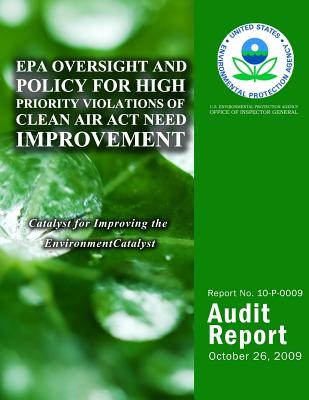
- We will send in 10–14 business days.
- Author: U S Environmental Protection Agency
- Publisher: CreateSpace Independent Publishing Platform
- Year: 2014
- Pages: 34
- ISBN-10: 1499735480
- ISBN-13: 9781499735482
- Format: 21.6 x 28 x 0.2 cm, softcover
- Language: English
- SAVE -10% with code: EXTRA
EPA Oversight and Policy for High Priority Violations of Clean Air Act Need Improvement (e-book) (used book) | bookbook.eu
Reviews
Description
High priority violations (HPVs) are significant violations of a federally-enforceable regulation by major and synthetic minor1 Clean Air Act (CAA) stationary sources. U.S. Environmental Protection Agency (EPA) policy states that HPVs should be addressed (formal enforcement action taken) or resolved (compliance achieved) within 270 days. According to EPA data, about 30 percent of State-led HPVs and about 46 percent of EPA-led HPVs were unaddressed after 270 days.2 If HPVs are not addressed in a timely manner, continued emissions from facilities may result in significant environmental and public health impacts, deterrence efforts being undermined, and unfair economic benefits being created. We undertook this review to determine why some EPA regions and States are not addressing HPVs under the CAA in a timely manner as set out in Agency policy, and what improvements are planned.
EXTRA 10 % discount with code: EXTRA
The promotion ends in 16d.10:20:52
The discount code is valid when purchasing from 10 €. Discounts do not stack.
- Author: U S Environmental Protection Agency
- Publisher: CreateSpace Independent Publishing Platform
- Year: 2014
- Pages: 34
- ISBN-10: 1499735480
- ISBN-13: 9781499735482
- Format: 21.6 x 28 x 0.2 cm, softcover
- Language: English English
High priority violations (HPVs) are significant violations of a federally-enforceable regulation by major and synthetic minor1 Clean Air Act (CAA) stationary sources. U.S. Environmental Protection Agency (EPA) policy states that HPVs should be addressed (formal enforcement action taken) or resolved (compliance achieved) within 270 days. According to EPA data, about 30 percent of State-led HPVs and about 46 percent of EPA-led HPVs were unaddressed after 270 days.2 If HPVs are not addressed in a timely manner, continued emissions from facilities may result in significant environmental and public health impacts, deterrence efforts being undermined, and unfair economic benefits being created. We undertook this review to determine why some EPA regions and States are not addressing HPVs under the CAA in a timely manner as set out in Agency policy, and what improvements are planned.


Reviews